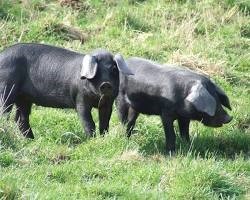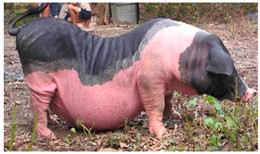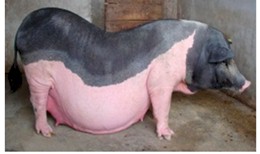 Lacombe
Lacombe
 Lacombe Pigs are a breed of Canadian pig. They are
named after the Lacombe Research Centre in Lacombe, Alberta. They were the
first strain of livestock developed in the Canada.
Lacombe Pigs are a breed of Canadian pig. They are
named after the Lacombe Research Centre in Lacombe, Alberta. They were the
first strain of livestock developed in the Canada. Lacombe Pigs development began in 1947 with the crossing of Berkshire sows to Danish Landrace and Chester White boars. The goal was to produce a pig that would be appropriate for crossing with the Yorkshire, the dominant breed in Canada at the time. The Lacombe was eventually unveiled to pork producers in 1957, and quickly grew to be a popular breed in Canada.
Lacombe Pigs are white, medium-sized, docile pigs. They have large drooping ears, are long bodied, short legs, and are very meaty.
Unfortunately today Lacombe Pigs are ...

 Landrace
Landrace
 Landrace Pigs are found in many countries with small variations from country to country; however, they are all descended from hogs that were developed in Denmark.
Landrace Pigs are found in many countries with small variations from country to country; however, they are all descended from hogs that were developed in Denmark.The development of Landrace Pigs began in about 1895. It resulted from crossing Large White hogs from England with native pigs. . It was largely thanks to the use of Landrace pigs that Denmark became a great bacon-exporting country.
Landrace Pigs care to merica in 1934 when the U.S. Department of Agriculture received a shipment of Landrace pigs from Denmark. Many of those hogs were used in cross breeding and became ancestors of a number of newrnbreeds. The foundation stock of the American Landrace was from those hogs that were bred pure or carried a small inf ...

 Lang Hong
Lang Hong
 Lang Hong pigs, also known as Langshan pigs, are an indigenous breed of domestic swine originating from the Shandong Province in China. They are characterized by their distinctive black and white markings, compact build, and hardy temperament.
Lang Hong pigs, also known as Langshan pigs, are an indigenous breed of domestic swine originating from the Shandong Province in China. They are characterized by their distinctive black and white markings, compact build, and hardy temperament.
Lang Hong pigs are considered medium-sized hogs, typically weighing between 180 and 250 kilograms (397 and 551 pounds) at maturity. Boars tend to be slightly larger than sows.
They have a compact and muscular build, with a slightly arched back and a deep chest. Their heads are medium in size, featuring erect ears and a slightly dished snout.
Their coats exhibit a distinctive black and white pattern, with the black patches typically covering the head, shoulders, back, ...

 Large Black
Large Black
 Large Black Hogs, occasionally called the Devon or
Cornwall Black, are a meet pig, originally from Great Britain, particularly
Devon, Cornwall, and Essex.
Large Black Hogs, occasionally called the Devon or
Cornwall Black, are a meet pig, originally from Great Britain, particularly
Devon, Cornwall, and Essex. Large Blacks were developed from local black pig breeds from the West Country and the East of England. With the founding of a breed association in 1898 or 1899, variations between the types from the two areas decreased. The Large Black was popular in the early 1900s and was exported to many areas of the world.
They are good foragers which makes them particularly useful for extensive farming but poor for intensive farming. Population numbers declined after the Second World War as farmers turned to breeds more suitable to intensive pig farming, and by the 19 ...

 Large White
Large White
 The Large White
is a breed of domestic pig originating in Yorkshire. They are one of the most
common pig breeds. Large Whites in the US are referred to as American
Yorkshires, or just Yorkshires.
The Large White
is a breed of domestic pig originating in Yorkshire. They are one of the most
common pig breeds. Large Whites in the US are referred to as American
Yorkshires, or just Yorkshires.As one would expect Large Whites are large and white. They have erect ears and a dished face.
They were originally developed as an outdoor breed, but today they are favored by commercial pig breeders.
First recognized in 1868, the Large White was one of the original founder breeds of the National Pig Breeders'' Association (now known as the British Pig Association) and the first herdbook was published in 1884. The early history of the breed in Yorkshire is difficult to trace. The huge, coarse-boned and leggy ...

 Latvian white
Latvian white
 The Latvian White Pig is a domestic breed originating from Latvia, a country in the Baltic region of Europe. These pigs are renowned for their distinct white coat, which is their defining characteristic. They typically have a medium-sized build, with adult pigs reaching weights between 150 to 250 kilograms (330 to 550 pounds), depending on factors such as age, genetics, and diet.
The Latvian White Pig is a domestic breed originating from Latvia, a country in the Baltic region of Europe. These pigs are renowned for their distinct white coat, which is their defining characteristic. They typically have a medium-sized build, with adult pigs reaching weights between 150 to 250 kilograms (330 to 550 pounds), depending on factors such as age, genetics, and diet.
Known for their adaptability and resilience, Latvian White Pigs are well-suited to various farming environments, including both intensive and extensive production systems. They are versatile animals that are primarily raised for pork production, valued for their excellent meat quality and efficient feed conversion rates.
With a docile temperam ...

 Leicoma
Leicoma
 Leicoma pigs, an endangered breed hailing from East Germany, are characterized by their robust build, large frame, and distinctive hanging ears. Despite facing near-extinction, efforts by organizations like the IBV (Information and Coordination Centre for Biological Diversity) have led to a resurgence in breeding initiatives, with the breeding stock rising to 83 sows and 21 boars by 2019.
Leicoma pigs, an endangered breed hailing from East Germany, are characterized by their robust build, large frame, and distinctive hanging ears. Despite facing near-extinction, efforts by organizations like the IBV (Information and Coordination Centre for Biological Diversity) have led to a resurgence in breeding initiatives, with the breeding stock rising to 83 sows and 21 boars by 2019.
Renowned for their exceptional meat quality, Leicoma pigs owe this trait to their genetic heritage, particularly influenced by the Duroc pig. Their robustness, coupled with pronounced motherliness and high milk yield, makes them invaluable assets for sustainable pig farming practices. Moreover, they exhibit high fattening performance, contribut ...

 Liang Guang
Liang Guang
 Liang Guang pigs, also known as Liangguang pigs, are an indigenous breed of domestic swine originating from the Guangxi Zhuang Autonomous Region and Guangdong Province in China. They are characterized by their distinctive black coloration, compact build, and hardy temperament.
Liang Guang pigs, also known as Liangguang pigs, are an indigenous breed of domestic swine originating from the Guangxi Zhuang Autonomous Region and Guangdong Province in China. They are characterized by their distinctive black coloration, compact build, and hardy temperament.
Liang Guang pigs are considered medium-sized hogs, typically weighing between 180 and 250 kilograms (397 and 551 pounds) at maturity. Boars tend to be slightly larger than sows.
They have a compact and muscular build, with a slightly arched back and a deep chest. Their heads are medium in size, featuring erect ears and a slightly dished snout.
Their coats exhibit a solid black coloration, ranging from deep black to slightly grayish-bl ...

 Lincolnshire Curly-Coated
Lincolnshire Curly-Coated
 Lincolnshire Curly-Coated Pigs, also known as the
Baston Pigs or simply as the Lincolnshire Curly
Coats, were an old breed of pigs from Lincolnshire,
England. The breed became rare, and was finally extinct by the early to mid-1970s.
Lincolnshire Curly-Coated Pigs, also known as the
Baston Pigs or simply as the Lincolnshire Curly
Coats, were an old breed of pigs from Lincolnshire,
England. The breed became rare, and was finally extinct by the early to mid-1970s.Lincolnshire Curly-Coated Pigs were bred to be tough and hardy. They were large and had lop ears. Their most prominent feature was their long, curly white coat, which helped it to weather the damp, cold winters of the Lincolnshire fens.
Lincolnshire Curly-Coated Pigs were one of the oldest breeds in the UK, and was formerly very common in eastern England. By the 1930s, selective breeding had developed its fattening abilities, and large specimens were exported to Russia and other c ...

 Lithuanian Native
Lithuanian Native
 Lithuanian Native
Pigs are a rare middle-sized pig from Lithuania. They can be traced back to
ancient times, and they are one of the oldest pig varieties in Europe. It is a
middle-sized breed.
Lithuanian Native
Pigs are a rare middle-sized pig from Lithuania. They can be traced back to
ancient times, and they are one of the oldest pig varieties in Europe. It is a
middle-sized breed.Lithuanian Native Pigs typically have wattles on the neck, and usually they have large black spots on their body, but color variations include black-and-white, ginger, black, and tri-colored. They are friendly and they are not sensitive to the sun, which makes them good grazers and ideal for small farms.
Lithuanian Native Pigs were used in producing the Lithuanian White, a standardized breed, and many Russian breeds. Now Lithuanian Native pigs are very rare even in Lithuania and in danger of extinction. However since 1993 a ...

 Lithuanian White
Lithuanian White
 The Lithuanian White Pig stands as a standardized and versatile breed, meticulously developed through the amalgamation of various genetic strains, including the indigenous Lithuanian Native Pigs. Renowned for its adaptability and multifaceted utility, this breed embodies the culmination of careful breeding practices and centuries of agricultural tradition in Lithuania.
The Lithuanian White Pig stands as a standardized and versatile breed, meticulously developed through the amalgamation of various genetic strains, including the indigenous Lithuanian Native Pigs. Renowned for its adaptability and multifaceted utility, this breed embodies the culmination of careful breeding practices and centuries of agricultural tradition in Lithuania.
With a focus on versatility and functionality, the Lithuanian White Pig has been meticulously refined to serve as a general-purpose breed, capable of fulfilling a wide range of agricultural roles. Whether utilized for meat production, lard extraction, or other agricultural endeavors, these pigs exhibit a remarkable degree of adaptability and resilience, making them ...

 Livny
Livny
 Livny Pigs are a general purpose pig from the Orel region of Russia. They
were developed by a team of specialists from the Livny Breeding Ground. Selective
pedigree work was carried out on the basis of the cross-breeding stock, which
was formed before 1917 by random outbreeding of local late-ripening pigs with
Berkshire, Large White, Middle White, and Polish-Chinese pigs.
Livny Pigs are a general purpose pig from the Orel region of Russia. They
were developed by a team of specialists from the Livny Breeding Ground. Selective
pedigree work was carried out on the basis of the cross-breeding stock, which
was formed before 1917 by random outbreeding of local late-ripening pigs with
Berkshire, Large White, Middle White, and Polish-Chinese pigs.As a result of monitoring 10 lines of boars and 28 breeding families, pigs improved for these parameters were obtained for productivity, precocity, and conformation, and in 1949 the name Livny breed was legally fixed.
They have good adaptability to natural and fodder conditions of Russia, as well as produce high quality meat. Livny pigs ...

 Luchuan
Luchuan
 Luchuan pigs, also known as Ryukyuan pigs, are an indigenous breed of domestic swine originating from the Ryukyu Islands, Japan. They are characterized by their distinctive reddish-brown coloration, compact build, and hardy temperament.
Luchuan pigs, also known as Ryukyuan pigs, are an indigenous breed of domestic swine originating from the Ryukyu Islands, Japan. They are characterized by their distinctive reddish-brown coloration, compact build, and hardy temperament.
Luchuan pigs are considered medium-sized hogs, typically weighing between 150 and 200 kilograms (331 and 441 pounds) at maturity. Boars tend to be slightly larger than sows.
They have a compact and muscular build, with a slightly arched back and a deep chest. Their heads are medium in size, featuring erect ears and a slightly dished snout.
Their coats exhibit a distinctive reddish-brown coloration, ranging from light reddish-brown to dark reddish-brown. This unique colorati ...
